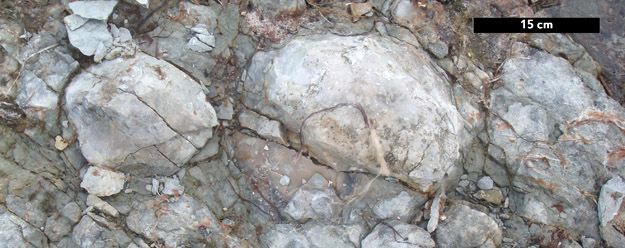Editor’s note: Senior Independent Study (I.S.) is a year-long program at The College of Wooster in which each student completes a research project and thesis with a faculty mentor. We particularly enjoy I.S. in the Geology Department because there are so many cool things to do for both the faculty advisor and the student. We are now posting abstracts of each study as they become available. The following was written by Rob McConnell, a senior geology major from Darby, Montana. Here is a link to his final PowerPoint presentation on this project.
In the summer of 2009, Wooster paleontologists Dr. Mark Wilson, Palmer Shonk, and I traveled to Estonia with fellow Ohio State University paleontologist Dr. Bill Ausich. Olev Vinn of the University of Tartu greeted us at the Tallinn Airport. We then proceeded by car to the island of Saaremaa in western Estonia. The city of Kuressaare would serve as our home for the next week as we conducted our research on the island.
My research describes two members of the Jaani Formation (Silurian, Wenlock): the older Mustjala Member and the younger Ninase Member. Samples of these two members were collected from three sites along the northern Saaremaa coast: Liiva Cliff, Suuriku Cliff, and Panga Cliff (Figure 1).
The purpose of my research is to describe and recreate the paleoenvironment of the Jaani Formation. I am doing this by analyzing thin-section slides, stromatoporoid sponges (Figure 2), and various other fossils such as corals and brachiopods. It appears thus far that the lower Mustjala Member is far more fossiliferous and contains larger stromatoporoids, many of which are still in life position. This indicates a tranquil shallow marine environment. Smaller and flatter sponges are found in the upper Mustjala Member, close to the Mustjala/Ninase boundary. This is likely because of a shallowing of the water through time (a regression).

Figure 2. Stromatoporoids from the Mustjala Member, Jaani Formation (Silurian, Wenlock) on Saaremaa, Estonia.
The Ninase Member has different characteristics than the Mustjala. In general, it is better cemented and contains fewer fossils. It also contains more brachiopods and fewer sponges. It may have been deposited in a higher energy environment. Continued analysis of both members is required to gain a better understanding of this approximately 420 million year old environment.



Pingback: Wooster Geologists » Blog Archive » Wooster Geologists return to Suuriku Cliff, Saaremaa, Estonia